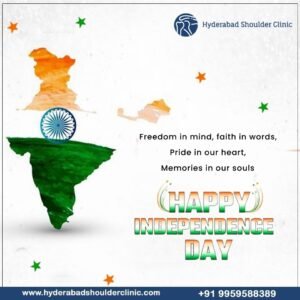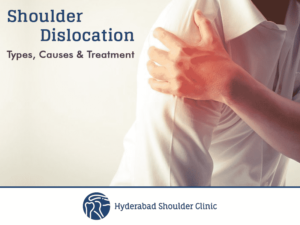Arthroscopic shoulder surgery is to treat rotator cuff tear. The rotator cuff is a group of tendons and muscles in a shoulder. Helps to lift and rotate arms. It keeps your shoulder joint in place. But sometimes the rotator cuff tendons are torn or pinched by the surrounding bones by Injuries, such as falling on the arm. But wear and tear from time to time can also affect your shoulders. The pain can be very severe.
In this article provided by Dr Chandra Sekhar:
- What is Rotator Cuff Tear?
- Arthroscopic Surgery for Repair of Rotator Cuff Tears
- What happens After Shoulder Arthroscopy And Rotator Cuff Repair
- How To Deal With postoperative Pain And Discomfort
- What Can You Expect From postoperative Physiotherapy
- Recovery from Rotator Cuff Surgery
- Conclusion
What is a Rotator Cuff Tear?

Rotator cuff tear is a common injury, especially in sports such as baseball or tennis, or when working as a paint or window cleaner. It usually happens over time due to normal use or when you repeat the same arm movements over and over. But it can happen when you fall on your arm or lift something heavy.
The most common method of tendon tear is to separate it from the upper shoulder bone. Small tears, then only one tendon gets rupture, but massive tears can occur, including three or even four rotator cuff tendons gets damaged. A doctor won’t recommend surgery inpatient who experiences little or no pain. If patients experience significant, sudden sharp rotator cuff tear pain, then a surgeon may recommend surgery, thereby reducing shoulder pain.
Treatment:
Surgical treatment:

Arthroscopic Surgery for Repair of Rotator Cuff Tears, surgery may be needed if:
- If you’re not getting any relaxation with no surgical treatments.
- If the shoulder pain does not improve after 6 to 12 months
- If you lost a lot of strength in your shoulder and it hurts to move
- Tear in your rotator cuff tendon
- If active and rely on the strength of your joints at work or in sports
Rotator cuff repair is an operation to repair a torn ligament on the shoulder. This procedure can be done with a large (open surgery) incision or shoulder arthroscopy using a smaller incision.
Two techniques are commonly used to repair rotator cuff fractures:
During an open repair, the surgeon makes a large incision and gently moves large muscles (deltoid muscles) along the way to do the surgery. The doctor recommends open surgeries with more significant or more complex fractures.
During the arthroscopy procedure: The doctor places the arthroscope through a small incision. This scope connected to a video monitor. It allows the surgeon to see the inside of the shoulder. One to three additional small incisions enable the insertion of other tools.
How a Surgeon Fixes a Rotator Cuff:
- The tendons are attached to the bone again.
- Often, small rivets (called anchor stitches) are used to attach tendons to the bone. These stitches are made up of metal or material that dissolves over time and does not need to remove.
- Sutures are attached to the anchor, which helps to reattach the tendon back to the bone.
In both surgeries, You will get general anaesthesia before this surgery. It means you sleep and don’t feel pain. Or you have regional anaesthesia. Your arms and shoulders will be numb so that you won’t feel any pain. If you receive local anaesthesia, you will also get medicines that will make you very sleepy during the operation.
At the end of the operation, the surgeon closes the incisions, and a bandage is applied. When arthroscopy surgery performed, most surgeons take photos of the procedure on a video monitor to show what they have found and what improvements have been
made.
What After your Shoulder Arthroscopy And Rotator Cuff Repair

- Local anaesthesia can hold your shoulder pain for several hours. After that, you will be prescribed an effective drug for pain relief at the hospital. If you feel you are not tolerating well, contact doctor and they will try another. Many patients find that lying down increases their discomfort. You can sleep better in a lying down position or in bed. A pillow behind the elbow can also help.
- It is usual for you to experience swelling and discomfort in the shoulder for several days or a week after surgery. Place an ice pack or use the cryo-cuff you received to control the swelling. Ice should be applied for 20-30 minutes at once every hour or two; cheesecloth or T-shirt on the skin when you use ice cream in a plastic bag. Icing is most important in the first 48 hours, although many believe that it helps relieve their postoperative pain.
- Keep the postoperative dressing clean and dry. Leave the bandages in place for at least two days remove it only when it becomes wet or too tight because of swelling. Two days after your surgery, remove your bandages. Cover the incisions with Band-Aids to keep from sticking the sutures on clothes. If you take a bath, try to keep the incisions dry for the first 10-14 days. Do not wet your incisions directly until at least two weeks postoperative.
- The stitches are absorbable, and no need to remove.
- Meet the doctor in hospital 10-14 days after surgery. If you don’t have an appointment for the first postoperative visit, contact the hospital and make the appointment.
- After surgery, start immediately with rehabilitation care. Your physiotherapy program is the key to successful results, so it must begin the day after surgery. A separate prescription describes the protocol of physiotherapy. It often helps to call before surgery to make an appointment with a physiotherapist or doctor may suggest you. Move the hand to maintain blood circulation and avoid stiffness after surgery.
- Don’t drink alcohol and don’t smoke.
- You can follow a healthy diet
- Plan to take a few days off work.
How To Deal With postoperative Pain And Discomfort?

Pain treatment is one of the main problems for patients after surgery. Anaesthesia and nerve blocks help deal with pain on the day of surgery, but when you are at home, you are responsible for treating your pain. Doctor team will help you prepare to go home to begin the recovery process. Here are some things you can do to feel comfortable after surgery.
- Icing: A pack of ice on your shoulder can help reduce pain and reduce swelling. Be careful not to wet the incision area when there is ice. Put a cheesecloth around the ice and apply it to your shoulders for about 20 minutes.
- Medications: A doctor may prescribe analgesics for you. You can also try various over-the-counter medications to treat pain. It is best to consult with your doctor before taking painkillers. Some medicines can affect bleeding. Always follow the instructions carefully when taking medicine.
- Sleeping: Sleeping is an essential part of recovery, but it can be a challenge immediately after surgery. It can take up to six weeks after surgery for you to sleep comfortably in a horizontal position. You might find it easier to sleep on the reclining chair. Or, you can rest in bed with a pillow. Be sure to support the diseased arm up and away from your body. If you prefer to sleep on your side, you can sleep on your other shoulder.
What Can Expect From postoperative Physiotherapy

Physical therapy plays a significant role in the treatment of rotator cuff post-surgery. Your physiotherapist will first introduce passive movements to shoulders. Then physiotherapist will move your arms carefully to ensure that your muscles and tendons are not exposed to excessive strain.
After that, your physical therapy switches to active movements, which means that your therapist tells you how to move your arms. Eventually, you will begin to strengthen your shoulders with resistance training. Even though you have regular physiotherapy appointments, your therapist will probably give you daily exercise at home. Rehabilitation must continue for several months after surgery.
Recovery from Rotator Cuff Surgery?

Recovery takes place in different phases. The first step is the treatment of your postoperative pain. Your arm may be in a sling for four to six weeks after surgery. After that, you can return most of your normal activities within a few days of operation. You can drive and go, but remember that you do these things with one hand. During the recovery period, work with your physical therapist to regain movement and strengthen the area.
The recovery time of a rotator cuff can vary from case to case, but full recovery requires four to six months. It may take longer to lift the weight to start again. Talk to a doctor and physiotherapist before continuing or exercising, which makes you feel a strain on the surgery hand.
Conclusion:
After you get a full recovery, you might want to remember the injury and move on with your life. Although extraordinary, you can return to activities that you like, and you want to take precautions to prevent rotator cuff injuries again. You can continue to exercise the rotator cuff you have learned in physiotherapy to keep your shoulders healthy. Return to the other type of exercise that you like before surgery. Fitness helps keep your body healthy and prevent future injuries.
Next time, ask for help if you need to lift something heavy. If you want to lift again, whether it’s for exercise or work, make sure a doctor and physiotherapist approve it to do. Also, make sure you lift in a way that keeps your body safe. When you realize that your shoulder is painful or sensitive, stop what you are doing. If you push or lift if you feel pain then again retear of the tendon occurs.
If you need arthroscopy surgery details, make an appointment with Dr Chandrasekhar or call 9959588389.





